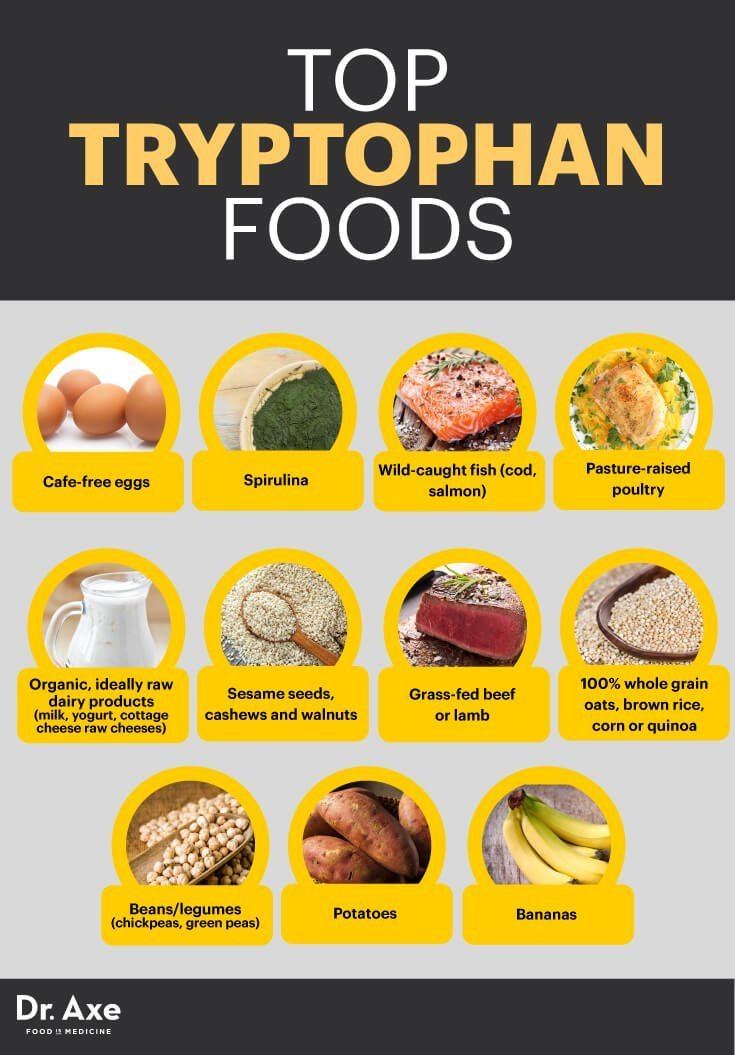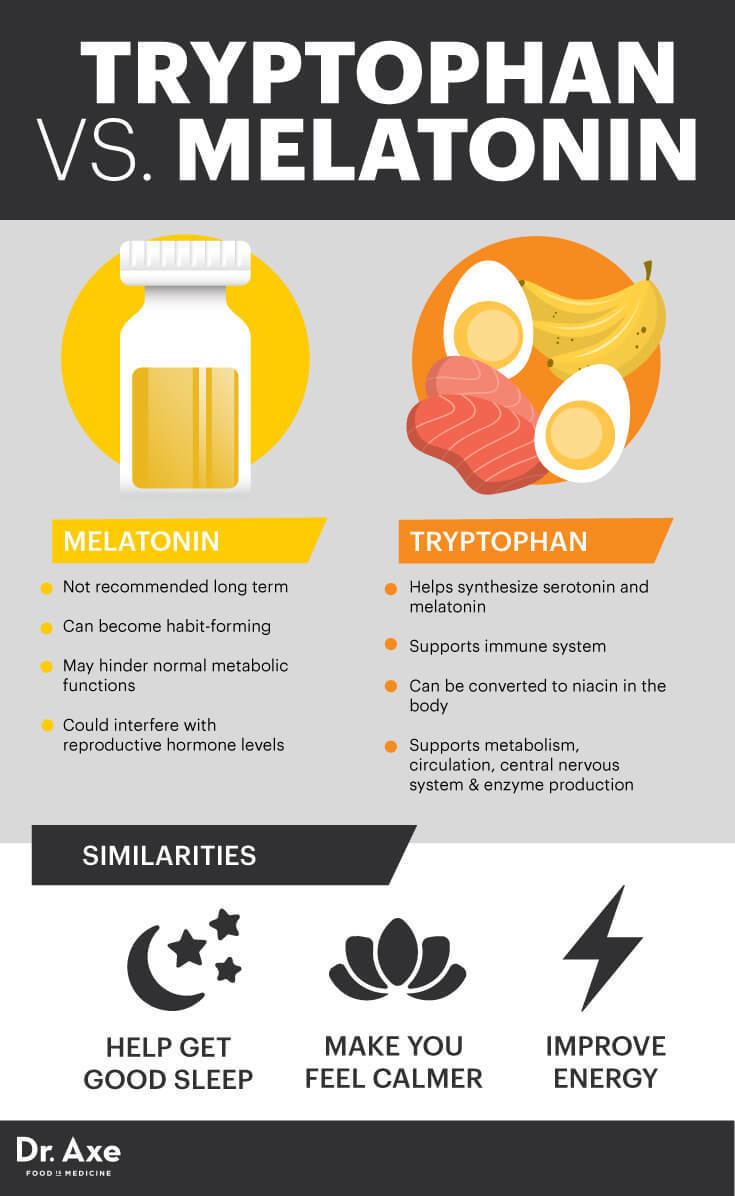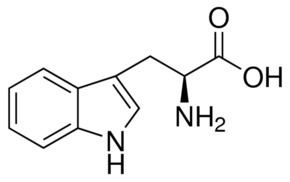Formula C11H12N2O2 Soluble in Water | Molar mass 204.225 g/mol | |
 | ||
Thermodynamic
data Phase behaviour
solid–liquid–gas IUPAC ID Tryptophan or (2S)-2-amino-3-(1H-indol-3-yl)propanoic acid | ||
Trp operon tryptophan operon regulation and attenuation
Tryptophan (abbreviated as Trp or W; encoded by the codon UGG) is an α-amino acid that is used in the biosynthesis of proteins. It contains an α-amino group, an α-carboxylic acid group, and a side chain indole, classifying it as a non-polar, aromatic amino acid. It is essential in humans, meaning the body cannot synthesize it and thus it must be obtained from the diet. Tryptophan is also a precursor to the neurotransmitters serotonin and melatonin.
Contents
- Trp operon tryptophan operon regulation and attenuation
- L tryptophan for anxiety or depression
- Isolation
- Biosynthesis and industrial production
- Function
- Use as a dietary supplement
- Side effects
- Interactions
- Research
- Fluorescence
- Eosinophiliamyalgia syndrome
- References

Like other amino acids, tryptophan is a zwitterion at physiological pH where the amino group is protonated (–NH3+; pKa = 9.39) and the carboxylic acid is deprotonated ( –COO−; pKa = 2.38).

L tryptophan for anxiety or depression
Isolation

The isolation of tryptophan was first reported by Frederick Hopkins in 1901 through hydrolysis of casein. From 600 grams of crude casein one obtains 4-8 grams of tryptophan.
Biosynthesis and industrial production

As an essential amino acid, tryptophan is not synthesized from more basic substances in humans and other animals, who must ingest tryptophan or tryptophan-containing proteins. Plants and microorganisms commonly synthesize tryptophan from shikimic acid or anthranilate by the following process: anthranilate condenses with phosphoribosylpyrophosphate (PRPP), generating pyrophosphate as a by-product. The ring of the ribose moiety is opened and subjected to reductive decarboxylation, producing indole-3-glycerinephosphate; this, in turn, is transformed into indole. In the last step, tryptophan synthase catalyzes the formation of tryptophan from indole and the amino acid serine.

The industrial production of tryptophan is also biosynthetic and is based on the fermentation of serine and indole using either wild-type or genetically modified bacteria such as B. amyloliquefaciens, B. subtilis, C. glutamicum or E. coli. These strains carry either mutations that prevent the reuptake of aromatic amino acids or multiple/overexpressed trp operons. The conversion is catalyzed by the enzyme tryptophan synthase.
Function
For many organisms (including humans), tryptophan is needed to prevent illness or death, but cannot be synthesized by the organism and must be ingested; in short, it is an essential amino acid. Amino acids, including tryptophan, act as building blocks in protein biosynthesis, and proteins are required to sustain life. In addition, tryptophan functions as a biochemical precursor for the following compounds (see also figure to the right):
The disorder fructose malabsorption causes improper absorption of tryptophan in the intestine, reduced levels of tryptophan in the blood, and depression. Some studies did not find reduced tryptophan in cases of lactose maldigestion.
In bacteria that synthesize tryptophan, high cellular levels of this amino acid activate a repressor protein, which binds to the trp operon. Binding of this repressor to the tryptophan operon prevents transcription of downstream DNA that codes for the enzymes involved in the biosynthesis of tryptophan. So high levels of tryptophan prevent tryptophan synthesis through a negative feedback loop and, when the cell's tryptophan levels are reduced, transcription from the trp operon resumes. The genetic organisation of the trp operon thus permits tightly regulated and rapid responses to changes in the cell's internal and external tryptophan levels.
Use as a dietary supplement
Tryptophan is sold over the counter in the United States, Canada, and the United Kingdom as a dietary supplement for use as an antidepressant, anxiolytic, and sleep aid. It is also marketed as a prescription drug in some European countries for the indication of major depression under various trade names.
Since tryptophan is converted into 5-hydroxytryptophan (5-HTP) which is subsequently converted into the neurotransmitter serotonin, it has been proposed that consumption of tryptophan or 5-HTP may therefore improve depression symptoms by increasing the level of serotonin in the brain. In 2001 a Cochrane Review of the effect of 5-HTP and tryptophan on depression was published. The authors included only studies of a high rigor and included both 5-HTP and tryptophan in their review because of the limited data on either. Of 108 studies of 5-HTP and tryptophan on depression published between 1966 and 2000, only two met the authors' quality standards for inclusion, totaling 64 study participants. The substances were more effective than placebo in the two studies included but the authors state that "the evidence was of insufficient quality to be conclusive" and note that "because alternative antidepressants exist which have been proven to be effective and safe, the clinical usefulness of 5-HTP and tryptophan is limited at present". The use of tryptophan as an adjunctive therapy in addition to standard treatment for mood and anxiety disorders is not supported by the scientific evidence. Due to the lack of high-quality studies and preliminary nature of studies showing effectiveness and the lack of adequate study on their safety, the use of tryptophan and 5-HTP is not highly recommended or thought to be clinically useful.
There is evidence that blood tryptophan levels are unlikely to be altered by changing the diet, but tryptophan is available in health food stores as a dietary supplement. Consuming purified tryptophan increases brain serotonin level, whereas eating foods containing tryptophan does not. This is because the transport system, which brings tryptophan across the blood-brain barrier, is also selective for the other amino acids, which are contained in protein food sources. High blood plasma levels of other large neutral amino acids prevent the plasma concentration of tryptophan from increasing brain concentration levels.
Side effects
Potential side effects of tryptophan include nausea, diarrhea, drowsiness, lightheadedness, headache, dry mouth, blurred vision, sedation, euphoria, and nystagmus (involuntary eye movements). Because tryptophan has not been thoroughly studied in a clinical setting, possible side effects and interactions with other drugs are not well known.
Interactions
Tryptophan taken as a dietary supplement (such as in tablet form) has the potential to cause serotonin syndrome when combined with antidepressants of the MAOI or SSRI class or other strongly serotonergic drugs.
Research
In 1912 Felix Ehrlich demonstrated that yeast attacks the natural amino acids essentially by splitting off carbon dioxide and replacing the amino group with hydroxyl. By this reaction, tryptophan gives rise to tryptophol.
Tryptophan affects brain serotonin synthesis when given orally in a purified form and is used to modify serotonin levels for research. Low brain serotonin level is induced by administration of tryptophan-poor protein in a technique called "acute tryptophan depletion". Studies using this method have evaluated the effect of serotonin on mood and social behavior, finding that serotonin reduces aggression and increases agreeableness.
Fluorescence
Tryptophan is an important intrinsic fluorescent probe (amino acid), which can be used to estimate the nature of microenvironment of the tryptophan. Most of the intrinsic fluorescence emissions of a folded protein are due to excitation of tryptophan residues.
Eosinophilia–myalgia syndrome
There was a large outbreak of eosinophilia-myalgia syndrome (EMS) in the U.S. in 1989, with more than 1,500 cases reported to the CDC and at least 37 deaths. After preliminary investigation revealed that the outbreak was linked to intake of tryptophan, the U.S. Food and Drug Administration (FDA) banned most tryptophan from sale in the US in 1991, and other countries followed suit.
Subsequent epidemiological studies suggested that EMS was linked to specific batches of L-tryptophan supplied by a single large Japanese manufacturer, Showa Denko. It eventually became clear that recent batches of Showa Denko's L-tryptophan were contaminated by trace impurities, which were subsequently thought to be responsible for the 1989 EMS outbreak. However, other evidence suggests that tryptophan itself may be a potentially major contributory factor in EMS.
The FDA loosened its restrictions on sales and marketing of tryptophan in February 2001, but continued to limit the importation of tryptophan not intended for an exempted use until 2005.
The fact that the Showa Denko facility used genetically engineered bacteria to produce the contaminated batches of L-tryptophan later found to have caused the outbreak of eosinophilia-myalgia syndrome has been cited as evidence of a need for "close monitoring of the chemical purity of biotechnology-derived products". Those calling for purity monitoring have, in turn, been criticized as anti-GMO activists who overlook possible non-GMO causes of contamination and threaten the development of biotech.
